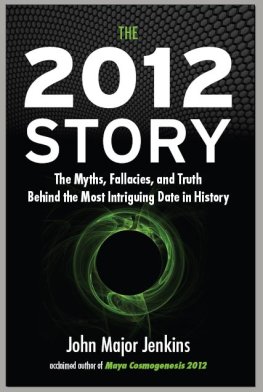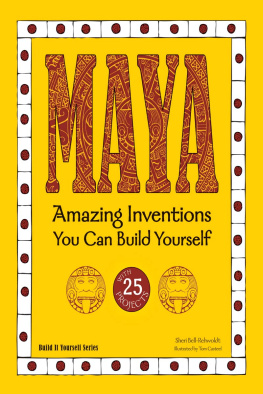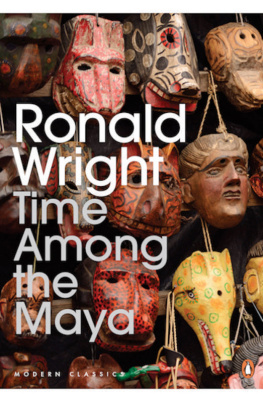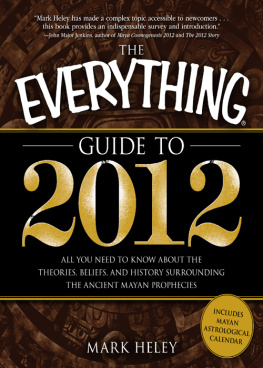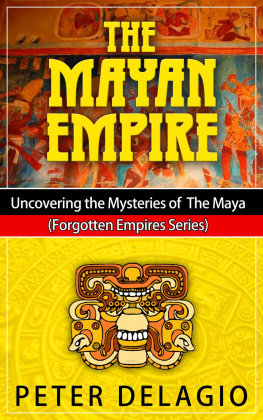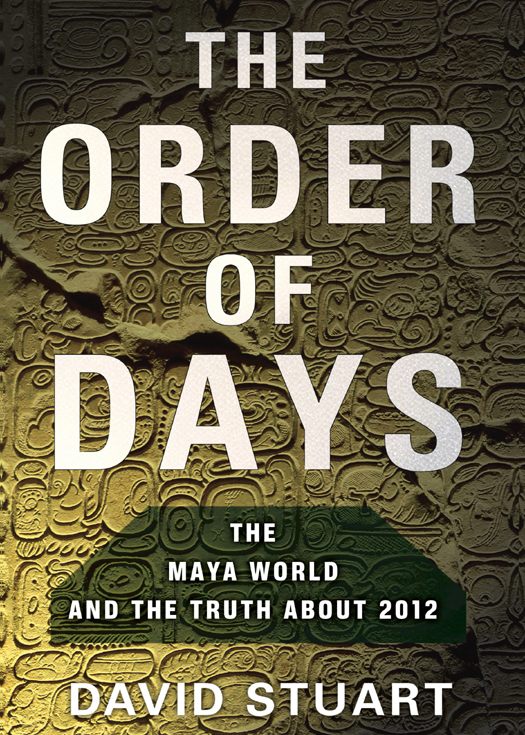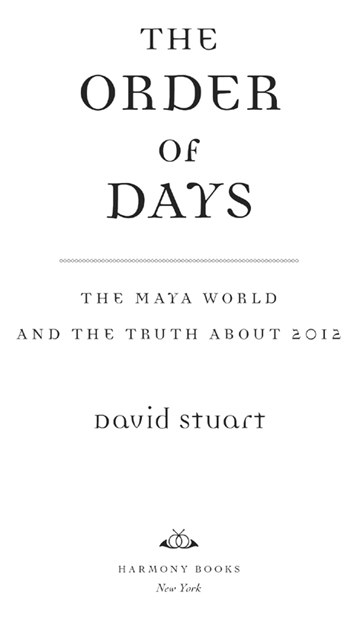
Copyright 2011 by David Stuart
All rights reserved.
Published in the United States by Harmony Books,
an imprint of the Crown Publishing Group,
a division of Random House, Inc., New York.
www.crownpublishing.com
Harmony Books is a registered trademark and the
Harmony Books colophon is a trademark of Random House, Inc.
Library of Congress Cataloging-in-Publication Data
Stuart, David, 1965
The order of days : the Maya world and the truth about 2012 / David Stuart.1st ed.
p. cm.
Includes bibliographical references.
1. Maya calendar. 2. Maya astronomy. 3. Maya cosmology. 4. Maya
Prophecies. 5. End of the world (Astronomy) 6. Two thousand twelve, A.D. I. Title.
F1435.3.C14S78 2011
529.32978427dc22
2010028515
eISBN: 978-0-307-72081-8
Jacket design by Kyle Kolker
Jacket photography by Jorge Prez de Lara
Map on drawn by Philip Winton for The Art of Mesoamerica: From Olmec to Aztec
by Mary Ellen Miller, Thames & Hudson, London and New York.
v3.1
For Peter and Richard
CONTENTS
AUTHORS NOTE
THE SPELLING AND PRONUNCIATION
OF MAYAN WORDS
T he spelling of Mayan words seems always to be a complex matter, and readers may well be confused by their look and the seemingly exotic sounds they represent. One important sound feature of Mayan is the glottal stop, represented generally by an apostrophe before a vowel, and sometimes after consonants such as k, t, or ch (hence k, t, or ch). The glottal stop involves an abrupt interruption or obstruction of airflow during speech, and while not a part of standard English phonology, many English speakers do often make use of it, as in the gap between the two utterances of uh oh. In Mayan these are often found after consonants, as in chak, or bak. Its important to stress that Mayan languages always distinquish words with glottalized and unglottalized consonants, so that in Yukatek Mayan, for example, kan means snake, but kan means yellow. The vowels of Mayan are much like those of Spanish.
In this book I have generally followed the standard spelling conventions used by specialists in Maya studies, with some important exceptions. The proper names of time periods, days and months, for example, conform to long-standing conventions and may not always agree with the preferred technical orthography used by modern linguists. Ajaw is the word for king in classic Mayan, but the similar day name I prefer to spell it as Ahaw, largely because the Yukatek Mayan language of the sixteenth century, where the day names we use come from, did not have a j. There are similar lines of reasoning behind some of the spellings that might at first look inconsistent or unconventional.
Some readers will no doubt wonder about the different usage of Maya and Mayan. The words are not synonymous: Maya is a general ethnic term and adjective (the ancient Maya or Maya art) whereas Mayan is reserved for the language group (Mayan languages, proto-Mayan, etc.). This distinction follows the general conventions used in recent years by anthropologists, linguists, and archaeologists. The plural forms Mayas or Mayans are sometimes used in popular writings (less so in academic literature) but will be avoided here in preference for the more simple Maya.
Thirty or so Mayan languages are spoken today in parts of Mexico, Belize, and Guatemala, and even in the streets and farm fields of the United States. Each language (Yukatek, Kiche, Chol, among many others) has its own distinctive sound-system and grammatical structure. The language of the ancient hieroglyphic texts I prefer to call Classic Mayan is ancestral to only a handful of these modern languages.
PREFACE
I n the last half-century, modern scholars have made an astounding intellectual journey. Beginning in the 1950s and 60s, archaeologists and historians finally began the rigorous process of understanding many key aspects of ancient Maya civilization, much of it by cracking the code of the elaborate Maya hieroglyphic script, left to us on hundreds of stone monuments and ceramic vessels. This work has enveloped me for most of my life, with my interest in the Maya beginning when I was a boy accompanying my parents on their expeditions to remote jungle ruins back in the 1970s. Over the years Ive been incredibly fortunate to participate in this transformation of knowledge, working with many colleagues in diverse fields to bring the ancient Maya from the realm of prehistory into that of history. Now, after several exciting decades, their written record is mostly understood, and it has forever changed our view of Maya history, religion, and culture. I like to think that were now at a place in the study of the ancient Maya not unlike where Egyptologists were in the early nineteenth century, at which time an ancient civilization suddenly was ripe for study in grand detail, right on the heels of the decipherment of Egyptian hieroglyphs by Jean-Franois Champollion. With regard to the Maya, we are nowadays in a similar heady time, albeit with far more scientific methodology and context in hand than early Egyptology ever had.
But has the popular understanding of ancient Mesoamerica and the Maya advanced so much? I have to wonder. Lately I find myself confused and even frustrated by what I see in the popular representation of the Maya in todays media, whether it be in print or on-screen. Seldom can I roam through a large retail bookstore, sit in front of a television, or surf the Web without seeing some reference to the year 2012, now just a couple of years away as I write this. Many of the books on 2012 have evocative, even alarming titles, such as Apocalypse 2012: An Investigation into Civilizations End; or The World Cataclysm in 2012: The Maya Countdown to the End of Our World; or 2012: The Return of Quetzalcoatl; or Maya Cosmogenesis 2012: The True Meaning of the Maya Calendar End-Date. According to many of these strange-sounding books and TV showsand none of them is ever consistent in its messagethe ancient Maya, having some keen insight into the mystical workings of our planet and the cosmos, were able to predict that the world would end or in some way be radically transformed in the year 2012on the winter solstice December 21, to be exact (although, again, some sources differ about the precise day).
This is all complete nonsense. As someone who has studied the Maya for nearly all of his life, and who specializes in reading their ancient texts in order to understand their history, religion, and culture, I have to lay down the line and assert that any such statements about the Maya predicting the worlds demise or, alternatively, some transformation of consciousness in 2012 is, to put it as simply and directly as possible, wrong. Not only wrong, but misleading.
Theres something larger at work here, more than just the ideas of a few kooks who have little interest in real Maya history and culture. The 2012 hubbub seems to be the most recent in a long chain of related theories and ideas about Mesoamericans, and the Maya in particular, depicting them as somehow oddball, not of this world, or having some strong mystical link to other realms and dimensions. As early as the nineteenth century, the emerging accounts of ancient civilizations in Mexico were widely seen as too impossibly advanced to be the handiwork of Indians, especially among many in the young United States, where native populations were being slaughtered, displaced, and culturally marginalized along an ever-increasing frontier. Some people claimed that the impressive ruins of Central America had to be the works of Phoenicians, Israelites, Scandinavians (?!), or even inhabitants of the lost continent of Atlantis. How could Indians have built such great cities and created such artwork?or so the thinking went. This notion was largely dispelled among scholars by the mid-1800s, as archaeology blossomed and exploration established no doubt about historical and cultural links between the ruined cities and the native inhabitants of the area. But by the twentieth century, the same vein of thinking had morphed somewhat, now depicting the ancient Maya not so much as Old World seafarers but as peaceful, star-gazing intellectuals little concerned with the real world of human affairs. No wonder, perhaps, that by the 1970s, pop culture references to the exotic Maya had them making direct contact with aliens, who, after all, must have built their cities using spaceships. Even today we see the same motif in movies and books. The most recent Indiana Jones filmalways good PR for archaeologyshows Maya pyramids in the Amazon, of all places, guarding crystal skulls and flying saucers.



